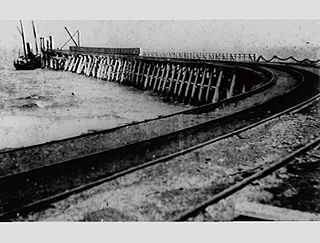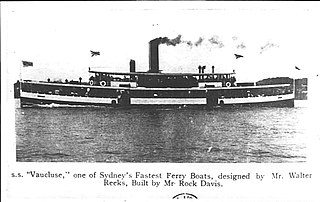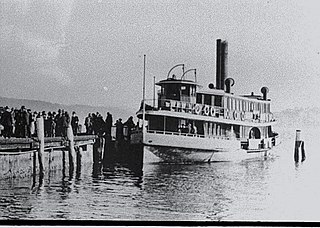
The SS Cawarra was a paddle-steamer that sank on 12 July 1866 in Newcastle harbour, New South Wales, Australia sending sixty people to their deaths. The sinking was one of the worst maritime disasters in Australian history.

The Greycliffe disaster occurred in Sydney Harbour (Australia) on 3 November 1927 when the harbour ferry Greycliffe and the Union Steamship Company mail steamer Tahiti collided. The smaller ferry was cut in two and sank with the loss of 40 lives, the deadliest incident on Sydney Harbour.
Archaeological evidence indicates that human beings have inhabited the area around Newcastle, New South Wales for at least 6500 years. In 2009, archaeologist uncovered over 5,534 Aboriginal artefacts, representing three occupation periods. In the 1820s, the Reverend Lancelot Threlkeld worked with local Awabakal man Biraban to record the Awabakal language. Since 1892, the Indigenous people of Newcastle have come to be known as the Awabakal.
The Advance was an iron screw steamer tug built in 1884 that was wrecked when she collided with Inverna off Catherine Hill Bay, New South Wales, Australia, on 25 December 1908.

MV Baragoola was a ferry formerly operated by the Port Jackson & Manly Steamship Company and its successors on the Manly service.

The Merksworth was an iron steamer screw built in 1874 at, Paisley, that was wrecked when it swamped whilst carrying coal between Newcastle and Sydney and was lost off Newcastle, Stockton Beach, New South Wales on 7 May 1898.

The Herald was an iron paddle steamer imported as frames from the United Kingdom and assembled in 1855 by Richard Johnson in Sydney Harbour, New South Wales, Australia, where she was registered. The Herald is one of the earliest iron paddle wheel steamers built in Australia, where she operated within Sydney Harbour. She was initially used on the fledgling North Shore route between Dawes Point and Blues Point by the newly formed North Shore Steam Company; however, due to not enough traffic to make her financially viable, she often performed tug duties. Eventually the North Shore Steam Company was wound up; the vessel was put up for sale but continued picking up business wherever it was available, operating as a tug, ferry, excursion boat and cargo vessel.

SS San Juan was a passenger steamship owned by the Los Angeles and San Francisco Navigation Company. Previously, she was owned by the Pacific Mail Steamship Company and White Flyer Line. At the age of 47 years, San Juan was involved in a collision with the steel-hulled oil tanker S.C.T. Dodd. Because of her aged iron hull, San Juan was fatally damaged in the collision and sank three minutes later, killing 65 people. The loss of San Juan was strikingly similar to the loss of Columbia.

Karrabee was a ferry operated by Sydney Ferries Limited and its NSW State Government operated successors on Sydney Harbour from 1913 until 1984. A wooden ferry built at the time of Sydney Ferries' rapid early twentieth century, she and near "sister", Karingal, were the smallest of the fleet of round-end "K-class ferries".

Sixty-miler (60-miler) is the colloquial name for the ships that were used in the coastal coal trade of New South Wales, Australia. The sixty-milers delivered coal to Sydney Harbour from ports and ocean jetties to the north and south of Sydney. The name refers to the approximate distance by sea—actually 64 nautical miles—from the Hunter River mouth at Nobbys to the North Head of Sydney Harbour.

Kummulla was a "K-class" ferry on Sydney Harbour. Launched in 1903, the timber-hulled steamer was built for Sydney Ferries Limited during the boom in cross-harbour ferry travel prior to the opening of the Sydney Harbour Bridge. She was decommissioned in 1934 after the 1932 opening of the Bridge.

Vaucluse was a ferry on Sydney Harbour that served on the Circular Quay to Watsons Bay run. She was launched in 1905, and was one of the fastest ferries in Sydney. She was sent to Newcastle after which her fate is unknown.

Kanimbla was a "K-class" ferry on Sydney Harbour. Launched in 1910, the timber-hulled steamer was built for Sydney Ferries Limited during the boom in cross-harbour ferry travel prior to the opening of the Sydney Harbour Bridge. Kanimbla was renamed "Kurra-Ba" in 1935. She was laid up in the 1940s and broken up in the 1950s.

Kookooburra was a "K-class" ferry on Sydney Harbour. Commissioned in 1907, the timber-hulled steamer was built for Sydney Ferries Limited during the boom in cross-harbour ferry travel prior to the opening of the Sydney Harbour Bridge. She was retired from Sydney Harbour service in 1947 after which she was sent to Newcastle. She is thought to have been broken up in 1959.

Karingal was a ferry operated by Sydney Ferries Limited and its NSW State Government operated successors on Sydney Harbour from 1913 until 1984. A wooden ferry built at the time of Sydney Ferries' rapid early twentieth century, she was the smallest of the round-end "K-class ferries".












